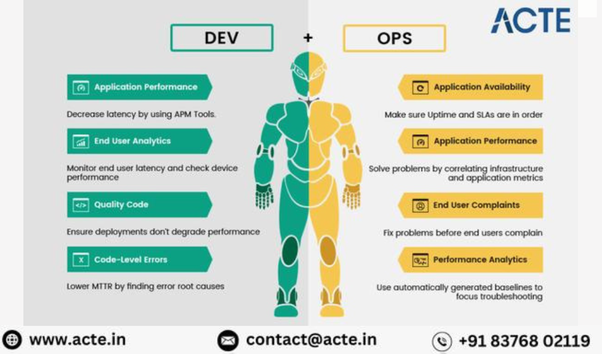Introduction
Implementing a DevOps approach in your organization can greatly enhance collaboration, efficiency, and productivity among your development and operations teams. By breaking down silos, is it so fundamental in the IT and programming improvement scene? Might we anytime separate it in more straightforward terms, brought to you by the Best Programming Preparing Foundation.

DevOps culture and mindset
One of the key aspects of implementing DevOps is fostering a culture and mindset that embraces collaboration, communication, and continuous learning. Here are some best practices to promote a DevOps culture in your organization:
1. Break down silos
Avoid departmental silos by encouraging cross-functional collaboration. Create opportunities for developers, operations teams, and other stakeholders to work together towards shared goals. This will help improve communication, understanding, and problem-solving.
2. Encourage openness and transparency
Ensure that information is shared openly and transparently across teams. Foster an environment where everyone feels comfortable expressing their ideas, concerns, and feedback. This will lead to better decision-making and more innovative solutions.
3. Emphasize continuous learning
Promote a learning culture where individuals are encouraged to acquire new skills and knowledge. Provide resources, training, and opportunities for professional development to help your teams stay up-to-date with the latest industry trends and best practices.
4. Foster collaboration and communication
Implement tools and practices that facilitate collaboration and communication among teams. Set up regular meetings, such as daily stand-ups or retrospectives, to discuss progress, challenges, and opportunities for improvement. Use collaboration tools, such as project management software or communication platforms, to keep everyone connected and informed.
- If you want to learn more about Data Science, I highly recommend the Devops online training because they offer certifications and job placement opportunities. You can find these services both online and offline.

DevOps tools and technologies
Implementing the right tools and technologies is crucial for the success of your DevOps implementation. Here are some best practices to consider:
1. Automation
Invest in automation tools and technologies to streamline manual tasks and repetitive processes. Automation helps reduce errors, increase efficiency, and accelerate the delivery of software. Consider tools for infrastructure provisioning, configuration management, deployment, and testing automation.
2. Version control and code management
Implement a version control system to manage your codebase effectively. Version control allows for collaboration, easy code sharing, and the ability to track and revert changes if needed. Choose a popular version control system like Git and establish good branching and merging practices.
3. Continuous integration and deployment
Set up a continuous integration and deployment pipeline to automate the build, test, and deployment processes. This ensures that every code change is validated and integrated into the main codebase, reducing the risk of conflicts and errors. Use tools like Jenkins, CircleCI, or Travis CI for continuous integration and deployment.
4. Monitoring and logging
Implement monitoring and logging tools to gain insights into the performance and health of your systems. Monitoring helps identify bottlenecks, detect anomalies, and ensure high availability. Use tools like Prometheus, Nagios, or ELK stack (Elasticsearch, Logstash, and Kibana) for monitoring and logging.
Key components of DevOps
DevOps comprises several key components that work together to create a seamless and efficient software delivery pipeline. Here are some essential components of DevOps:
1. Continuous integration (CI)
Continuous integration is the practice of regularly merging code changes into a shared repository and running automated tests. This ensures that each code change is validated and integrated early on, minimizing conflicts and catching errors sooner. CI enables teams to detect and resolve issues quickly, leading to faster and more reliable software delivery.
2. Continuous delivery (CD)
Continuous delivery extends continuous integration by automating the deployment of software to various environments, such as development, testing, and production. With continuous delivery, organizations can release software to production at any time, with confidence and minimal manual intervention. CD enables faster time-to-market and reduces the risk of deployment failures.
3. Infrastructure as code (IaC)
Infrastructure as code is the practice of managing infrastructure resources, such as servers, networks, and databases, using code and automation. By treating infrastructure as code, organizations can version, test, and deploy infrastructure changes with the same level of rigor as software changes. IaC promotes consistency, repeatability, and scalability in infrastructure management.
4. Monitoring and feedback loops
Monitoring and feedback loops are essential components of DevOps that provide insights into the performance and health of software systems. Monitoring helps identify issues, bottlenecks, and opportunities for optimization, while feedback loops enable teams to continuously improve their processes and make data-driven decisions. By leveraging monitoring and feedback loops, organizations can ensure high availability, performance, and customer satisfaction.
Conclusion
Implementing DevOps in your organization requires a combination of culture, mindset, and the right tools and technologies. By fostering collaboration, communication, and continuous learning, and leveraging automation, version control, continuous integration, and other DevOps practices, organizations can achieve faster and more reliable software delivery. Remember that DevOps is not just about technology; it's a cultural shift that requires ongoing commitment and investment. Embrace DevOps as a journey towards continuous improvement and innovation, and you'll reap the rewards of a more efficient and productive organization.























